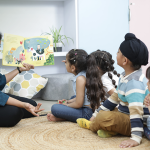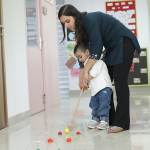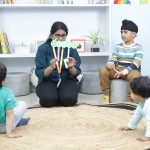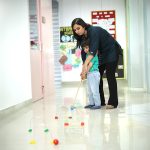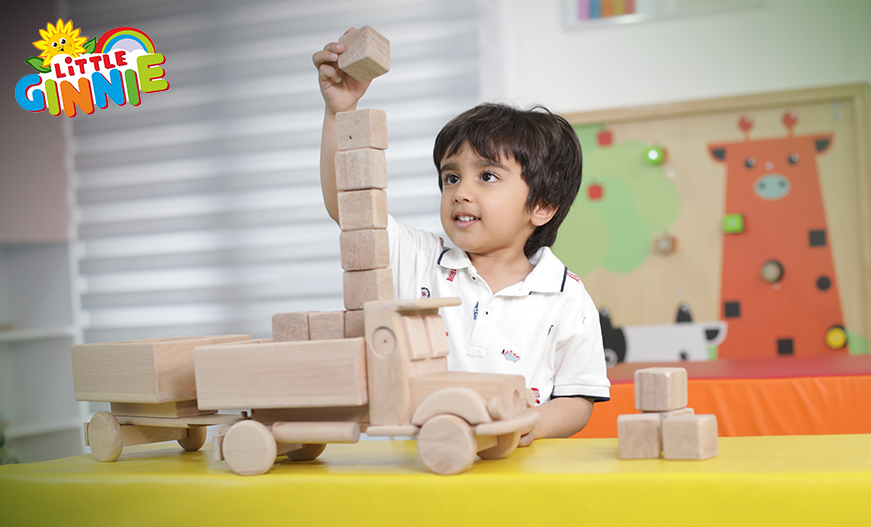
Are you ready to undertake an exciting journey into the world of pre-primary education? Have you ever wondered how we can lay a strong foundation for a child’s academic journey and overall development? What if there were creative and innovative strategies that could make learning more engaging and effective for young children?
Join us as we explore seven creative approaches to fulfilling pre-primary education goals at Preschools, ensuring a fun and enriching learning experience for every child. Let’s explore the exciting world of early childhood education together!
1. Sensory Play: A Feast for the Senses
Young children learn best through exploration and hands-on experiences. Sensory play activities engage multiple senses, stimulating brain development and promoting cognitive growth
Here are some ideas:
- Nature Scavenger HuntsOrganize outdoor adventures where children collect leaves, pinecones, and other natural objects. Back in the classroom, they can sort their treasures by size, color, or texture.
- Playdough ExtravaganzaHomemade or store-bought playdough provides endless opportunities for creative exploration. Children can mold shapes, create pretend food or practice letter formation. Adding essential oils or spices introduces them to different scents.
- Water ExplorationWaterplay is a classic for a reason! Set up a sensory bin filled with water, plastic containers, and measuring cups. Children will have a blast experimenting with pouring, scooping, and creating waterfalls.
2. Storytelling Magic: Spark Imagination and Language Development
The power of storytelling is undeniable. It captures children’s attention, ignites their imaginations, and enhances language development.
- Interactive Storytelling Don’t just read stories – act them out! Use puppets, props, and different voices to bring characters to life. Encourage children to participate by creating sound effects or joining in on repetitive phrases.
- Story Creation StationsSet up a storytelling corner with various materials, such as felt boards, paper bags, and construction paper. Children can create their own stories using these props and let their imaginations soar.
- Storytelling Through MusicSing songs and rhymes together! Many nursery rhymes and children’s songs tell stories. Singing and movement also promote language skills and social interaction.
3. The Great Outdoors: Learning in Nature’s Classroom
Nature is a treasure trove of learning opportunities. Taking children outside allows them to connect with the natural world, develop gross motor skills, and learn about science concepts firsthand.
- Nature Walks and ExplorationSchedule regular walks in parks or green spaces. Encourage children to observe their surroundings, identify different plants and animals, and collect natural objects for further exploration in the classroom.
- Outdoor Learning CentersCreate designated outdoor areas with materials for building, digging, and exploring. Mud kitchens, sandboxes, and climbing structures encourage creative play and physical activity.
- Gardening FunPlant a small garden together. Children can learn about plant lifecycles, take responsibility for watering and weeding, and enjoy the fruits (or vegetables!) of their labor.
4. Dramatic Play: Stepping into Different Roles
Dramatic play allows children to explore their creativity, develop social skills, and practice problem-solving. Here’s how to make it a hit:
- Dress-Up CornerProvide a dedicated space with costumes, hats, and props. Children can dress up as doctors, firefighters, or their favorite characters and act out real-life scenarios or stories they’ve read.
- Puppet ShowsCreate a puppet theater using cardboard boxes or fabric. Children can use hand puppets or finger puppets to put on shows for their classmates, developing storytelling skills and confidence.
- Dramatic Play PromptsOffer simple prompts to spark imaginative play. For example, set up a dramatic play area as a grocery store or a restaurant, providing props like play food and shopping baskets.
5. Arts and Crafts: A Celebration of Creativity
Art activities allow children to express themselves creatively, develop fine motor skills, and learn about colors, shapes, and textures.
- Open-Ended Art Exploration Provide a variety of art materials, such as paints, crayons, markers, and playdough, with minimal guidance. Let children explore freely and create art based on their interests.
- Process ArtFocus on enjoying the creative process rather than the finished product. Activities like finger painting, splatter painting, and collages encourage exploration and experimentation.
- Art IntegrationConnect art activities to other learning areas. For instance, after reading a story about a farm, children can create pictures of farm animals using different art materials.
6. Building Blocks: Learning Through Play
Blocks are a timeless classic for a reason. They offer endless possibilities for creative construction, problem-solving, and the development of spatial reasoning skills.
- Block Play BasicsProvide a variety of block types, such as wooden blocks, plastic building sets, or large foam blocks. Let children explore freely, build towers, create elaborate structures, or work collaboratively on group projects.
- Block Play ChallengesOffer prompts or challenges to encourage specific skills. For example, challenge children to build a bridge that can hold a toy car or create a structure that is as tall as they are.
- Block Play IntegrationCombine block play with other learning areas. Children can build models of animals they are learning about in science class or create a block city with roads and buildings for dramatic play.
7. Music and Movement: A Symphony of Learning
Music and movement are powerful tools for engaging young learners, promoting physical development, and enhancing cognitive skills.
- Sing and Dance PartiesIncorporate regular singing and dancing sessions into the classroom routine. Use movement songs, action rhymes, or simply play lively music and encourage children to move their bodies freely.
- Musical Instrument ExplorationProvide a variety of age-appropriate musical instruments, such as drums, shakers, and tambourines. Children can explore making sounds and experiment with creating simple rhythms.
- Movement BreaksSchedule short movement breaks throughout the day to help children release energy and refocus. Simple jumping jacks, stretches, or following the leader games can do wonders for classroom energy levels.
The Final Note: Fostering a Love of Learning
By incorporating these creative strategies into your pre-primary education program, you can create a stimulating and engaging learning environment for young children. Remember, the goal is to foster a love of learning, nurture curiosity, and equip children with the skills they need to thrive. When learning is fun and engaging, children are more likely to retain information, develop a positive attitude towards school, and become lifelong learners.
What are some creative strategies you use to make learning fun and engaging for young children? Share your tips and experiences in the comments section below! We’d love to hear from you.
FAQs
Q: How can I create a stimulating learning environment at home?
A: Even at home, you can create a stimulating learning environment for your child. Provide them with open-ended toys, art materials, and opportunities for sensory play. Read stories together, sing songs, and encourage exploration of the outdoors.
Q: What are some of the benefits of play-based learning?
A: Play-based learning allows children to learn through exploration, experimentation, and problem-solving. It promotes cognitive development, social skills, emotional well-being, and creativity.
Q: How can I encourage a love of reading in my child?
A: Read to your child regularly, starting at a young age. Let them choose books they are interested in and make reading time a positive and enjoyable experience. Visit your local library and participate in storytime sessions.
Preschools are committed to providing a nurturing and stimulating environment where young children can learn, grow, and thrive. We hope this article has provided some valuable ideas for fostering a love of learning in young children.


